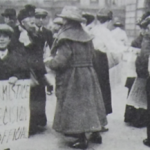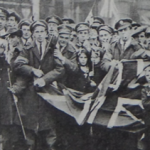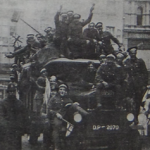Monday 11th November 1918 At 10.40 a.m news reached the Echo office by telephone that The Armistice had been signed at 5 a.m. that morning and came into force at 11 a.m. The discussion between the German delegates and those of the Allies had lasted all night. A special edition of the newspaper was immediately printed and distributed.
Discover how Cheltenham celebrated an end to fighting.
Stop Press in the Echo “From all parts of the country reports arrive of almost indescribable enthusiasm and public rejoicing.”
The Senior Curate at Cheltenham’s Parish Church declared that for four years life has been the hope of the moment of the armistice but that it was strange how simple it was when it came. The Home Office announced that restrictions were withdrawn for one week on the use of fireworks, the pealing of church bells and the striking of public clocks. Within an hour of the news being broadcast the hooters on the electrical works and the brewery sounded out – a warning of joy not of an impending raid, for which they had been intended.
“The Cheltonians are usually an indemonstrative folk: but today they have been letting themselves ‘go’! They are mildly mafficking! Armageddon over at last.” This was how the paper described Cheltenham on Monday 11th November. The several hundred cadets from the aeronautical school at The Priory London Road were the first to start the celebrations outside the Queen’s Hotel, with a feu de joie (a celebratory rifle salute fired by rifles in rapid succession). The next day their departure from Cheltenham was to be announced. They boarded lorries and careered around the streets waving flags and shouting for all they were worth. It was reported that “As everybody said, it was a godsend the cadets were there…for by ourselves we would have enthused feebly, instead we had infectious vitality.” Soon the employees in the various factories in town, allowed out by the bosses, joyfully downed tools and flocked into the streets. On the door of the Fruit Pulping Factory a notice had been posted “This factory will be closed until 6 a.m. tomorrow. We cannot work in these joyous times.”
Rich and poor, businesses and shops all seem to have found a supply of Union Jacks and flags of the Allies to parade with or drape outside their premises. The bars were thronged with people. One person cheekily asked Superintendent Hopkins of the Police “May we buy you a drink?” He had had to decline.(Treating people to a drink was banned under the Defence of the Realm Act).
Grammar School boys in their mortar boards liberated a large drum from the school band and marched with it up and down the “High”. All manner of ‘musical’ instruments produced a cacophony of sound around the town, mingled with happy voices, cheering and singing and in the background a sound, not heard for 4 years, that of the ringing of the bells of St. Mary’s (The Minster). After morning school was over a half day holiday was declared and all young Cheltenham turned into the streets adding more music and colour. As the day wore on, people appeared on the streets with faces rouged and painted in “horribly inflammatory shades”, everyone in Cheltenham was out celebrating, it seemed. Even the Mayor indulged in a modest button-hole flag of 9 inches x 6 inches. There were plenty enough soldiers in Cheltenham both able bodied and injured to add to the throng and every horse had at least one flag attached to its harness.
At 3.19 p.m. twelve bell ringers rang joyous peals from the St. Mary’s Parish Church in the Grandsire method – a peal of 5,040 changes, ending at 6.26p.m. The bells had been silenced since 1914.
In the evening at 6.30p.m. the Volunteer Band headed a procession from the Drill Hall in North Street from where the E and F Companies of the 5th Battalion of the Gloucestershire Regiment had headed out, the first soldiers from Cheltenham to leave the town on 5th August 1914. This time the band was playing National Airs of the Allies and people joined the procession and followed the band. The electrical company staff had removed the darkened globes over the powerful lights in the main streets so that, after years of gloom, the town was ablaze with an illumination more intense than ordinary peace time.
Tuesday 13th November 1918 The rejoicing continued the next day with a giant impromptu procession by the 2,000 workstaff from H.H. Martyn’s aeroplane factory at Sunningend and the Winter Gardens. The parade was headed by the work’s band with several full sized Bristol fighter planes on lorries and thousands of the workers, both male and female, carrying parts of the planes as trophies. Following came decorated cars, festooned with flags and banners, a bugle band, a full brass band and ending with the work’s firemen. The Echo commented “It was a wonderfully striking affair, for it gave a hint of the forces of vitality and patriotism especially of the women of our land, which converted the industrial energies into the weapons of war before which ultimately the Hun bit the dust.”
That evening at 7 p.m., a big torchlight procession, organised by the Sunningend workers and the aeronautical cadets. started out from the Midland railway station, opposite the Sunningend Works at Lansdown and travelled down Queen’s Road, into Lansdown Place, Bath Road, the High Street and up the Promenade to the Queen’s Hotel. The torches became a bonfire.
What a very different bonfire outside the Queen’s Hotel on Tuesday 12th November 1918 from that on the eve of war 3rd August 1914 at Stonewall Fields. What a very different Cheltenham.
In the words of the Rector of Cheltenham, Rev H.A Wilson, in his sermon at the Thanksgiving service on that same day, Tuesday 12th November 1918:
“It is a time in our history of such tremendous and bewildering import, we are so dazed by the wonder of it all, that to attempt a summing up is beyond the mind of man. The war is over.”
THE END
From “Cheltenham in the Great War” by Neela Mann (2016, The History Press)



Leave a Reply